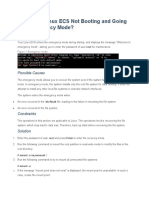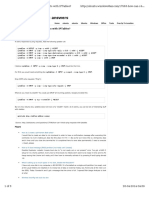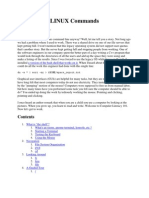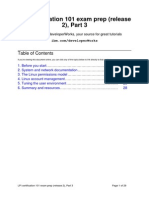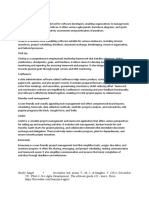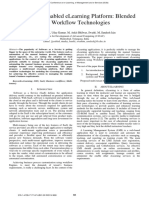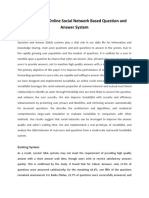How To Fix "Failed To Mount Etcfstab" Error in Linux
Uploaded by
John DoeHow To Fix "Failed To Mount Etcfstab" Error in Linux
Uploaded by
John DoeLearn Linux in One Week and Go From Zero to
Hero - Get This Book
! Menu
! Menu $
How to Fix “failed to
mount /etc/fstab” Error
in Linux
Aaron Kili Last Updated: June 27, 2017
Linux Commands 10 Comments
PV Panel Mounting Structure
ART SIGN offer Japan
standarded aluminum and
carbon steel solar panel
ground mounting.
In this article, i will explain how to solve
“failed to mount /etc/fstab” boot error
in Linux. The file in question contains
descriptive information concerning the
filesystems the system can mount
automatically at boot time.
This information is static and is read by
other programs on the system such as
mount, umount, dump and fsck. It has
six important filesystem mount
specification fields: the first field
describes the block special device or
remote filesystem to be mounted, the
second field defines the mount point for
the filesystem and the third specifies the
filesystem type.
The fourth field defines the mount
options associated with the filesystem,
and the fifth field is read by dump tool.
The last field is used by fsck tool to
establish the order of filesystem-checks.
Suggested Read: How to
Determine and Fix Boot Issues in
Linux
After editing the /etc/fstab to create an
automount and rebooting my system; it
booted into emergency mode showing
the error message below.
Linux Emergency Mode
I logged in as root from the interface
above, and typed the following
command to look through the systemd
journal; then I saw the errors shown in
the screen shot (indicated using red).
PV Panel Mounting Structure
ART SIGN offer Japan
standarded aluminum and
carbon steel solar panel
ground mounting.
As you can see, the main error (failure
of etc-fstab.mount unit) lead to several
other errors (systemd unit dependency
issues) such as failure of local-fs.target,
rhel-autorelabel-mark.service etc.
# journalctl -xb
Boot Error Messages
Causes of “failed to mount
/etc/fstab” Error in Linux
The error above may result from any of
the issues below, in the /etc/fstab file:
missing /etc/fstab file
wrong specification of filesystem
mount options,
failing mount points or
unrecognized characters in the
file.
To solve it, you can use the original file if
you created a backup, otherwise
comment out any changes you made
using the “#” character (and also ensure
that all the uncommented lines are
filesystem mount lines).
So I opened the /etc/fstab using vi/m
text editor to check for any errors.
# vi /etc/fstab
Linux /etc/fstab File
I realized I had typed an “r” letter at
the beginning of the file as shown in the
screen shot above – this was
recognized by the system as a special
device which did not actually exist in
the filesystem, thus resulting to the
sequential errors shown above.
This took me several hours before
noticing and fixing it. So I had to remove
the letter, commented out the first line in
the file, closed and saved it. After
running a reboot, the system booted
well again.
How to Avoid Such Issues
in the Future
To avoid encountering such issues on
your system, take note of the following:
Always create a backup of your config
files before editing them. In case of any
errors in your configs, you can revert to
the default/working file.
For instance:
# cp /etc/fstab /etc/fstab.orig
Secondly, check config files for any
errors before saving them, certain
applications offer utilities to check
syntax of config files before running the
application. Use these utilities where
possible.
However, if you happen to get any
system errors messages:
First look through the systemd journal
using the journalctl utility to determine
what exactly caused them:
# journal -xb
If you can’t resolve the errors in one
way or the other, run to any of the
millions of Linux forums on the web and
post the issue there.
Do check out some useful related
articles.
A Basic Guide to Linux Boot
Process
4 Best Linux Boot Loaders
Manage Log Messages Under
Systemd Using Journalctl
[Comprehensive Guide]
Managing System Startup
Process and Services (SysVinit,
Systemd and Upstart)
Process Management in RHEL 7:
Boot, Shutdown, and Everything
in Between
That’s it for now. In this article, I
explained how to solve the “failed to
mount /etc/fstab” boot error in Linux.
Once again, to avoid such issues (or if
you encounter any boot issues),
remember to follow the guidelines
offered above. Lastly, you can add your
thoughts to this guide via the feedback
form below.
% Linux FAQ's
& How to Install Speed Up Nginx
LEMP (Linux, Performance with
Nginx, MariaDB, Ngx_Pagespeed on
PHP-FPM) on CentOS 7 "
Debian 9 Stretch
If you liked this article, then do
subscribe to email alerts for Linux
tutorials. If you have any questions
or doubts? do ask for help in the
comments section.
If You Appreciate
What We Do Here
On TecMint, You
Should Consider:
TecMint is the fastest
growing and most trusted
community site for any kind
of Linux Articles, Guides
and Books on the web.
Millions of people visit
TecMint! to search or
browse the thousands of
published articles available
FREELY to all.
If you like what you are
reading, please consider
buying us a coffee ( or 2 )
as a token of appreciation.
We are thankful for your
never ending support.
Related Posts
Check Linux Configuration Files
30 Ways to Validate
Configuration Files or Scripts in
Linux
How to Create File in Linux
8 Practical Examples of Linux
“Touch” Command
MySQL Backup and Restore
Commands for Database
Administration
How to Run a Linux Command
Without Saving It in History
How to Run a Command
Multiple Times in Linux
Disable Su Access to User
How to Disable ‘su’ Access for
Sudo Users
10 thoughts on “How
to Fix “failed to mount
/etc/fstab” Error in
Linux”
chaitanya
October 23, 2020 at 11:12 am
Hi, I have tried with the above
one but it did not work. I cant
able to write in /etc/fstab and
while opening the /etc/sudoers
file it is showing as permission
denied.
Can you please help me to
resolve the issue?
Reply
john
August 31, 2020 at 6:25 pm
Hi,
I am currently experiencing the
same issue with an incorrect
statement in my fstab file. when
I use vim to edit /etc/fstab and
correct the problem, I can’t save
the file because it says it is a
read-only file. how do I bypass
this in order to save the
correction made to the fstab
file?
Thanks
Reply
Aaron Kili
September 1, 2020 at 12:11 pm
@John
Try to edit it with sudo or root
privileges:
$ sudo vim /etc/fstab
OR
# vim /etc/fstab
Reply
Jack H
September 1, 2020 at 12:43 pm
@john, Simply shift-right-click
a folder previous (like the etc
folder) and choose to open as
administrator (or whatever the
verbiage is).
Reply
Brian Brian
September 14, 2017 at 12:07 pm
Your tutorial makes sense,
however I as hoping to see you
address the issue, what if your
system says “cannot cd into
/etc/fstab no such directory or
file“?
It is an Ubuntu 14.04 with an
ubuntu3.13-107 generic kernel.
We were having frequent
power brownouts.
Reply
Aaron Kili
September 14, 2017 at 1:39 pm
@Brian
This was a practical problem
that i faced before, that is why
i came up with the solution.
Most times you’ll encounter
the failed to mount /etc/fstab
or Cannot read /etc/fstab: file
not found; these are the two
most common errors with
/etc/fstab file.
If the file is missing(say
accidentally deleted), then you
need to recover it, in case you
have a backup you can restore
the it or else manually add all
the necessary auto-mount
entries.
Reply
PV Panel Mounting Structure
ART SIGN offer Japan standarded aluminum and carbon steel
solar panel ground mounting. #
ART SIGN
Michael Get Quote
You might also like
- Authorization Review - SLIM - USER - CLF - HELPNo ratings yetAuthorization Review - SLIM - USER - CLF - HELP16 pages
- How To Auto Mount Partitions On Boot in Linux EasilyNo ratings yetHow To Auto Mount Partitions On Boot in Linux Easily4 pages
- Linux Filesystem Explained. If you have ever used a Linux system… _ by Tuna Cici _ MediumNo ratings yetLinux Filesystem Explained. If you have ever used a Linux system… _ by Tuna Cici _ Medium1 page
- CANNOT ACCES Inout Outpur Error in LinuxNo ratings yetCANNOT ACCES Inout Outpur Error in Linux5 pages
- Xfs - Repair An LVM On Centos or Other DistrosNo ratings yetXfs - Repair An LVM On Centos or Other Distros15 pages
- Boot Troubleshooting of OS.. Here we will discuss all about boot… _ by The_Anshuman _ MediumNo ratings yetBoot Troubleshooting of OS.. Here we will discuss all about boot… _ by The_Anshuman _ Medium21 pages
- How To Fix Dual Boot Issue With OS X Yosemite and Ubuntu - Make Tech EasierNo ratings yetHow To Fix Dual Boot Issue With OS X Yosemite and Ubuntu - Make Tech Easier8 pages
- Creating Kali Linux Live USB With Persistence, A Simple GuideNo ratings yetCreating Kali Linux Live USB With Persistence, A Simple Guide6 pages
- Backing Up Linux and Other Unix-Like SystemsNo ratings yetBacking Up Linux and Other Unix-Like Systems6 pages
- Repairing File Systems With FSCK in AIX (LED 517 or 518)No ratings yetRepairing File Systems With FSCK in AIX (LED 517 or 518)3 pages
- Answers To Even-Numbered Exercises: From Page 1077No ratings yetAnswers To Even-Numbered Exercises: From Page 10777 pages
- Why Is My Linux ECS Not Booting and Going Into Emergency ModeNo ratings yetWhy Is My Linux ECS Not Booting and Going Into Emergency Mode16 pages
- 4.3. Partitioning Hard Drive(s) : Mount Root /dev/hda3No ratings yet4.3. Partitioning Hard Drive(s) : Mount Root /dev/hda32 pages
- FSCK - Check & Repair Unix and Linux File SystemsNo ratings yetFSCK - Check & Repair Unix and Linux File Systems4 pages
- Fix Minimal BASH Like Line Editing Is Supported GRUB Error in Linux - It's FOSSNo ratings yetFix Minimal BASH Like Line Editing Is Supported GRUB Error in Linux - It's FOSS5 pages
- Redhat Enterprise Linux: Rajarshi HaldarNo ratings yetRedhat Enterprise Linux: Rajarshi Haldar68 pages
- Linux Installation On An Acer Laptop HowtoNo ratings yetLinux Installation On An Acer Laptop Howto7 pages
- Ubuntu Questions Answers: How Can I Block Ping Requests With Iptables?No ratings yetUbuntu Questions Answers: How Can I Block Ping Requests With Iptables?3 pages
- Red Hat Linux Installation and Root Password Cracking.No ratings yetRed Hat Linux Installation and Root Password Cracking.89 pages
- Build Your Raspberry Pi File Server A Step-by-Step GuideNo ratings yetBuild Your Raspberry Pi File Server A Step-by-Step Guide9 pages
- Mylinuxramblings: How To Backup and Restore Your Home DirectoryNo ratings yetMylinuxramblings: How To Backup and Restore Your Home Directory7 pages
- LINUX Commands Why Bother?: Du - S - Sort - NR $HOME/space - Report100% (1)LINUX Commands Why Bother?: Du - S - Sort - NR $HOME/space - Report33 pages
- Linux Essentials: Bootdisks and The Boot ProcessNo ratings yetLinux Essentials: Bootdisks and The Boot Process30 pages
- End Term Question Paper Linux For Devices 2021 SolutionsNo ratings yetEnd Term Question Paper Linux For Devices 2021 Solutions19 pages
- Basic Data Analysis Using ROOT: .X Treeviewer.cNo ratings yetBasic Data Analysis Using ROOT: .X Treeviewer.c58 pages
- Embedded Linux System Development Training Lab BookNo ratings yetEmbedded Linux System Development Training Lab Book4 pages
- File System Basics File Hierarchy StandardNo ratings yetFile System Basics File Hierarchy Standard19 pages
- LP I Part 3 Intermediate AdministrationNo ratings yetLP I Part 3 Intermediate Administration29 pages
- 6300-103C Powershield 8 Configuration ManualNo ratings yet6300-103C Powershield 8 Configuration Manual89 pages
- DDOOCP Assignment Spring 2024 - Summer 2025 [7039] (2)No ratings yetDDOOCP Assignment Spring 2024 - Summer 2025 [7039] (2)5 pages
- Multi-Tenant Enabled Elearning Platform: Blended With Workflow TechnologiesNo ratings yetMulti-Tenant Enabled Elearning Platform: Blended With Workflow Technologies5 pages
- 74.SocialQ&a An Online Social Network Based Question and Answer SystemNo ratings yet74.SocialQ&a An Online Social Network Based Question and Answer System5 pages
- NSE5 - FAZ-6.0.premium - Exam.25q: Number: NSE5 - FAZ-6.0 Passing Score: 800 Time Limit: 120 Min File Version: 1.0No ratings yetNSE5 - FAZ-6.0.premium - Exam.25q: Number: NSE5 - FAZ-6.0 Passing Score: 800 Time Limit: 120 Min File Version: 1.013 pages
- Bizhub C3850FS/C3850/C3350: Quick GuideNo ratings yetBizhub C3850FS/C3850/C3350: Quick Guide76 pages
- Debre Markos University Institute of Technology School of ComputingNo ratings yetDebre Markos University Institute of Technology School of Computing9 pages



















